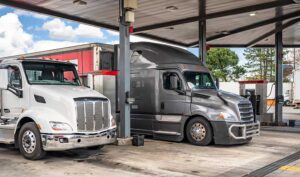The U.S. Environmental Protection Agency (EPA) is proposing a new and stronger set of greenhouse gas standards for heavy-duty vehicles for model years 2027 through 2032, building from the “Phase 2” greenhouse gas standards established in 2016.
Earlier, in December 2022 the EPA finalized its new national clean air standards to cut smog- and soot-forming emissions from new heavy-duty trucks beginning with model year 2027. That action was the first under EPA’s three-stage Clean Trucks Plan.
According to the EPA, the newest “Phase 3” greenhouse gas standards “would significantly reduce carbon emissions from heavy-duty vehicles and, through the increased use of zero-emission vehicle technology projected in the proposal, would also reduce emissions of smog and soot-forming pollutants and help to address the challenges of global climate change and air pollution in communities near major roadways.”
The requirements — and time frame — have been met with resistance from many. In May, the House approved a measure that would cancel a part of the EPA’s Clean Trucks Plan that went into effect in March. The Senate had previously voted to overturn the rule in April.
At the time of this writing, the legislation is on its way to the desk of President Joe Biden. The White House has said the president will veto it. To override a presidential veto would require a two-thirds vote in both the House and Senate.
Texas Republican Rep. Troy E. Nehls, who introduced the resolution, called the EPA’s rule on buttoning up large commercial truck emissions “yet another example of burdensome federal regulation” that “would unfairly target the trucking industry and pass costs for the American consumer and small businesses, all in the name of the Biden administration’s ‘woke’ climate-change agenda.”
Truckload Carriers Association (TCA) President Jim Ward has said the association and numerous other trucking groups “have cautioned the EPA against enacting this rule because it outpaces available technology and would worsen an already-tight equipment market.”
The TCA is concerned the new emissions standards for heavy-duty trucks will limit equipment options for carriers Ward says, as well as worsen environmental outcomes in the long run by raising prices and, in effect, disincentivizing fleet turnover, which is key to reducing emissions in trucking.
“TCA maintains that a more comprehensive strategy is needed to guide fleet advancements, that realistically accounts for ongoing equipment shortages and price increases, and encourages solution-maximizing technology, without restricting equipment options prematurely,” Ward said.
Addressing the Arkansas Trucking Association on May 17, Chris Spear, president and CEO of the American Trucking Associations, said the trucking industry needs to speak out against the new EPA rules. He contends the trucking industry and the associations that serve it have already made great strides in helping to reduce emissions on diesel engines.
“For 40 years, we have worked hand-in-glove with the SmartWay program with the EPA. We have recognized carriers that have kept up with the latest environmentally friendly equipment,” Spear said, adding that the industry has “been through the process to ensure equipment on the market can withstand the pressures that drivers put them through and still deliver reductions for the environment.”
According to Spear, truck manufacturers have, in the past four decades, reduced harmful emissions from big rigs by 98.5%. It would take 60 modern Class 8 trucks, he said, to match the emissions produced by a single rig back in 1988.
The EPA estimated the technology required to meet the new rule’s standards will cost between $2,568 and $8,304 per vehicle. The American Truck Dealers Association estimates it is more likely a $42,000 increase per truck. In total, the EPA projects the associated costs of this new regulation on the country.
In addition to tractors, including day cabs and sleepers, the proposed Phase 3 rulemaking applies to heavy-duty vocational vehicles, such as delivery trucks, refuse haulers, public utility trucks, and transit, shuttle, and school buses.
The proposed program revises standards for model year 2027 vehicles to be more stringent than the existing Phase 2 greenhouse gas standards. It also introduces new standards that become more stringent every model year from 2028 through 2032. For sleeper cab tractors, the proposed Phase 3 program introduces new standards in model year 2030 that increase in stringency in model years 2031 and 2032.
According to the EPA, the Phase 3 program “maintains the flexible structure created in the Phase 2 greenhouse gas program, which is effectively designed to reflect the diverse nature of the heavy-duty industry.” Under that structure, the proposed standards do not mandate the use of a specific technology. Internal combustion engine and zero-emission vehicle (ZEV) technologies are both expected to play important roles in reducing greenhouse gas emissions.
The proposed standards are performance-based, allowing each manufacturer to choose what set of emissions control technologies is best suited for their vehicle fleet to meet the standards. EPA projects that one potential pathway for the industry to meet the proposed standards would be through:
- 50%: ZEVs for vocational vehicles in model year 2032, which includes the use of battery electric and fuel cell technologies.
- 34%: ZEVs for day cab tractors in model year 2032, which includes the use of battery electric and fuel cell technologies.
- 25%: ZEVs for sleeper cab tractors in model year 2032, which primarily includes the use of fuel cell technologies.
“Greenhouse gas emissions have significant impacts on public health and welfare,” EPA officials said, noting that “transportation is the single largest U.S. source of greenhouse gas emissions, making up 27% of total greenhouse gas emissions.” Within the transportation sector, heavy-duty vehicles are the second largest contributor, at 25% of all transportation sources.
The proposed Phase 3 program is expected to increase the adoption of zero-emission heavy-duty vehicles, which the EPA says would reduce emissions of smog and soot forming pollutants by 650 tons of particulate matter, 72,000 tons of nitrogen oxides, and 21,000 tons of volatile organic compounds, compared to 2055 levels without the proposal.
The EPA estimates the total benefits of the proposed Phase 3 standards will far exceed the total cost by as much as $320 billion.
“Society would realize approximately $87 billion in climate benefits and up to $29 billion in benefits from fewer premature death and serious health effects such as hospital admissions due to respiratory and cardiovascular illnesses, along with approximately $12 billion in reduced reliance on oil imports,” noted a statement issued by the EPA.
In the meantime, trucking industry stakeholders are stuck in a holding pattern.
This article originally appeared in the July/August 2023 edition of Truckload Authority, the official publication of the Truckload Carriers Association.
Linda Garner-Bunch has been with The Trucker since 2020, picking up the reins as managing editor in 2022. Linda has nearly 40 years of experience in the publishing industry, covering topics from the trucking and automotive industry to employment, real estate, home decor, crafts, cooking, weddings, high school sports — you name it, she’s written about it. She is also an experienced photographer, designer and copy editor who has a heartfelt love for the trucking industry, from the driver’s seat to the C-suite.














